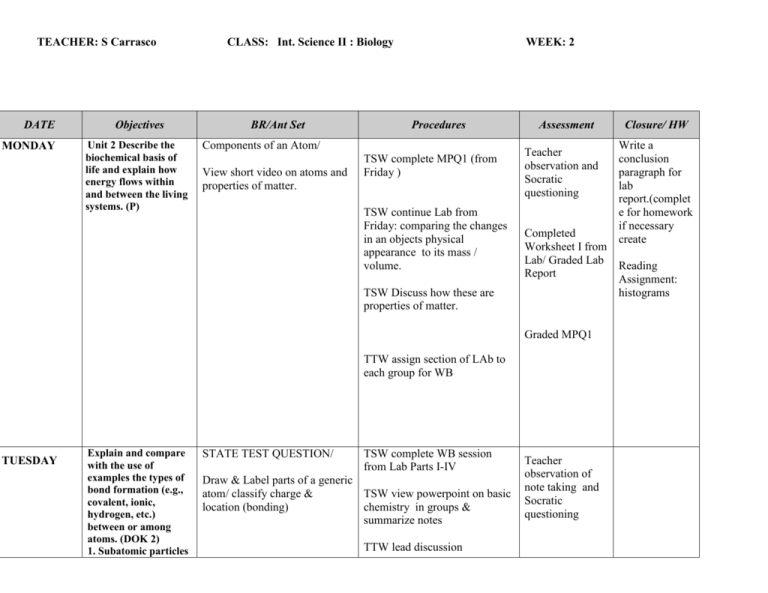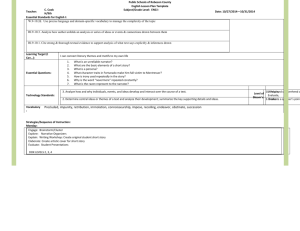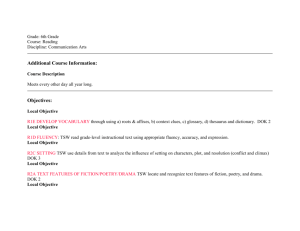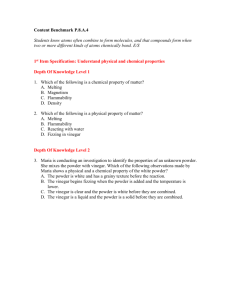teacher - SchoolRack
advertisement

TEACHER: S Carrasco DATE MONDAY Objectives Unit 2 Describe the biochemical basis of life and explain how energy flows within and between the living systems. (P) CLASS: Int. Science II : Biology BR/Ant Set WEEK: 2 Procedures Components of an Atom/ View short video on atoms and properties of matter. TSW complete MPQ1 (from Friday ) TSW continue Lab from Friday: comparing the changes in an objects physical appearance to its mass / volume. Assessment Teacher observation and Socratic questioning Completed Worksheet I from Lab/ Graded Lab Report TSW Discuss how these are properties of matter. Graded MPQ1 TTW assign section of LAb to each group for WB TUESDAY Explain and compare with the use of examples the types of bond formation (e.g., covalent, ionic, hydrogen, etc.) between or among atoms. (DOK 2) 1. Subatomic particles STATE TEST QUESTION/ TSW complete WB session from Lab Parts I-IV Draw & Label parts of a generic atom/ classify charge & TSW view powerpoint on basic location (bonding) chemistry in groups & summarize notes TTW lead discussion Teacher observation of note taking and Socratic questioning Closure/ HW Write a conclusion paragraph for lab report.(complet e for homework if necessary create Reading Assignment: histograms misconceptions and identify specific properties of an atom/ elements & periodic table . and arrangement in atoms 2. Importance of ions in biological processes WEDNESDA Y THURSDAY Unit 2 Describe the biochemical basis of life and explain how energy flows within and between the living systems. (P) Explain and compare with the use of examples the types of bond formation (e.g., covalent, ionic, hydrogen, etc.) between or among atoms. (DOK 2) 1. Subatomic particles and arrangement in atoms STATE TEST QUESTION Discussion of notes from power point. MP #2 After discussion of notes, students will do an independent activity on atoms and bonding. TSW select an atom from the periodic table and discuss properties, including particle count and bonding properties. Teacher observation and Socratic questioning Check effort on notes Graded for correctness Discuss the MP answers Teacher observation 2. Importance of ions in biological processes FRIDAY Explain and compare with the use of examples the types of bond formation (e.g., covalent, ionic, hydrogen, etc.) between or among atoms. (DOK 2) 1. Subatomic particles and arrangement in atoms 2. Importance of ions in biological processes ACT QUESTION Prepare to whiteboard Whiteboard yesterday’s activity and present in selected groups. Teacher observation and Socratic questioning Put up/clean up boards etc… 1 Conduct a scientific investigation demonstrating safe procedures and proper care of laboratory equipment. (DOK 2) a 1. Safety rules and symbols 2. Proper use and care of the compound light microscope, slides, chemicals, etc. 3. Accuracy and precision in using graduated cylinders, balances, beakers, thermometers, and rulers b Formulate questions that can be answered through research and experimental design. (DOK 3) c Apply the components of scientific processes and methods in classroom and laboratory investigations (e.g., hypotheses, experimental design, observations, data analyses, interpretations, theory development). (DOK 2) d Construct and analyze graphs (e.g., plotting points, labeling x-and y-axis, creating appropriate titles and legends for circle, bar, and line graphs). (DOK 2) e Analyze procedures, data, and conclusions to determine the scientific validity of research. (DOK 3) f Recognize and analyze alternative explanations for experimental results and to make predictions based on observations and prior knowledge. (DOK 3) g Communicate and defend a scientific argument in oral, written, and graphic form. (DOK 3) Unit 2 Describe the biochemical basis of life and explain how energy flows within and between the living systems. (P) a Explain and compare with the use of examples the types of bond formation (e.g., covalent, ionic, hydrogen, etc.) between or among atoms. (DOK 2) 1. Subatomic particles and arrangement in atoms 2. Importance of ions in biological processes











